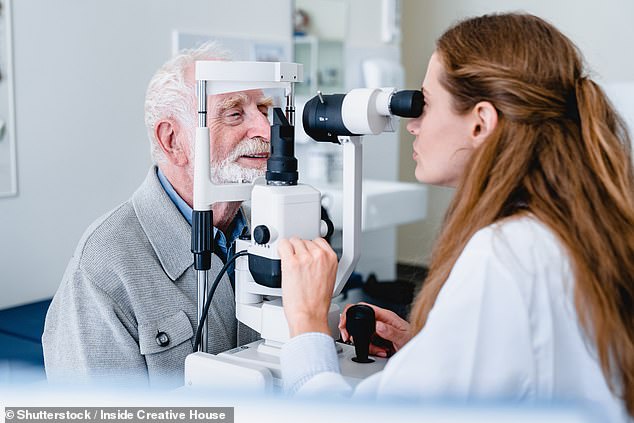A top eye expert has urged people to get checked out if you have experienced any of the following symptoms… they can be warning signs of blindness.
While some people are born blind, others can either suddenly or gradually, lose their sight completely or partially.
Kyla Black, director of Optical Practice at Boots Optician told the Daily Mail: ‘Many people experience temporary problems which are often treatable.’
This can be with glasses, that an optician will prescribe after a test, or lifestyle changes they recommend.
‘However, in rare cases, there are warning signs that could indicate more serious issues within the eye.
‘It is always recommended to get your eyes out if you notice any changes to your vision.’
As you get older, you’re more likely to experience sight loss, added Sheraz Daya, an eye surgeon at Centre for Sight, who has over 40 years experience.
‘We have a population that’s getting older, and they need to be educated about prevention.’

A top eye doctor has revealed four warning signs you need to book an opticians appointment
1. Blurred vision
The first warning sign, Ms Kyla warns, is blurred vision, which she explained is ‘when we look at an image and it loses some of its sharpness and definition’.
‘This can be caused by a change in your glasses or it could simply be a sign of tired a sign of tiredness,’ she said.
‘However, if it comes on suddenly, persists, or is accompanied by other symptoms, it could indicate a more serious issue that requires medical attention.’
Slightly different, is changes to peripheral vision, which Mr Daya warned could be a sign of a glaucoma.
It is estimated that there are 708,000 in the UK are living with glaucoma, damage to the optic nerve, which can cause irreversible vision loss and blindness if not treated.
The silent sight robber, he warned, ‘is not easy to detect’. He explained: ‘A lot of people who have it, don’t know it, because they don’t feel anything.
‘You just one day go “Oh, that bus went past, I didn’t see it”. Or your peripheral vision goes,’ he said. But he warned at this stage it is often ‘too late’.
So he urged people to get a check up at least once a year that includes an optical coherence tomography (OCT) scan which can detect it.
2. Flashers and floaters
Next, she warned, to look out for flashers or floaters which appear as specks or threads that drift in your vision.
‘Many people experience flashes or floaters at some point, especially as we get older. These are usually harmless,’ Ms Black reassured.
‘Flashes can appear as arcs, sparkles or flickers of light at the edge of your vision which are not visible.’
But she added: ‘Rarely, flashes and floaters can be caused by retinal tear or detachment.’
This, she explained: ‘Is where the retina—which is the light sensitive layer at the back of the eye—separates from the back of the eye.’
The serious medical problem called retinal detachment, if left untreated, could lead to permanent vision loss in the eye.
It is thought to affect around every one in 10,000 people in the UK every year and is most common in over 40s.
If you experience them, as with any other new changes, Ms Black says you should get it investigated.

This graph above shows where floaters and flashes that you see actually are in the eye
3. Red eyes
The third troublesome sign to look out for is red eyes, she warned, which can be in one or both eyes.
‘It could be a sign of a minor eye condition like conjunctivitis that may require mild treatment,’ she explained.
‘However if you’re experiencing significant discomfort and/or pain, it could indicate a more serious issue, so early diagnosis is essential.’
While conjunctivitis, also known as pink eye, most likely won’t cause you blindness, but in rare cases, if left untreated, it can lead to sight loss.
4. Straight lines suddenly appearing wavy
If you notice lines suddenly becoming wavy, she warned this could be another warning sign.
‘This symptom could indicate that you have an eye condition like age-related macular degeneration (AMD),’ Ms Black explained.
‘AMD is a common condition that generally affects people as they get older.
‘Although it doesn’t generally cause complete blindness, it can make day-to-day activities like reading and recognising faces difficult.’
However Mr Daya said: ‘AMD is the leading cause of permanent blindness in the elderly.
‘They’re not blind… It’s not that they can’t see at all. They just lose their central vision. If they look directly at something, it’s missing.
‘Macular degeneration usually starts off as dry macular degeneration, and then it becomes wet.
‘When it becomes wet, patients will notice their vision dropped, or they find that straight lines are becoming a bit squiggly.
He added: ‘Those who smoke are at a higher risk of AMD, and they get it worse. So the advice is people should quit smoking.’
This article was originally published by a www.dailymail.co.uk . Read the Original article here. .

